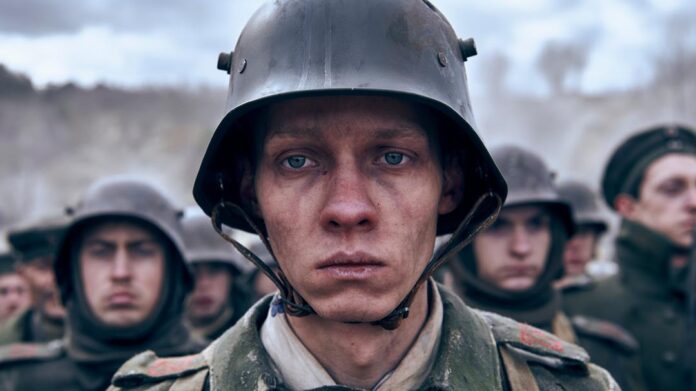“There’s no such thing as an antiwar film,” is a phrase made famous by French film director Francois Truffaut that reflects and criticizes how war films glorify combat in war. Thrilling and colourful displays of violence, adventure, and fighting for a purpose. Carefully curated depictions of charismatic camaraderie and trauma to capture and hook the audience. Movies entertain and tell stories, but without delving too far into the overall accuracy and true portrayal of war.
Edward Berger’s adaptation of the famous WWI book All Quiet on the Western Front by Erich Maria Remarque does fall prey to having thrilling and suspenseful combat scenes and has some incredible cinematography. However, Berger’s film is as close to a true antiwar film as the book that it is adapted from. The scenes of no man’s land and trench warfare are colour-graded with a grey, monotone palette which highlights the blunt and brutally honest horrors of war. Berger’s film briefly shows the war propaganda the German generals and governments used to recruit their youth for the army. Well-crafted scenes dynamically show the living conditions, driving home the disillusionment that the majority of the young soldiers experienced.
While the classic 1930s adaptation is a masterpiece in its own right, Berger’s version is the first adaptation that is cast with German actors and is spoken in their language. The film’s great storytelling and acting are easily appreciated when watched in German with subtitles.
The film opens with a silent forest, calm and peaceful. A family of foxes nests together and there is calm in the forest. Then the surface of a battle is shown. The raw and cold bodies, gunfire, and bullets pop through the air and off the ground. A battle starts, the stark contrast between everyday nature and brutal warfare. Berger’s limited score kicks in as the audience is introduced to a young boy named Heinrich, who begins to panic in the trenches and fights to survive.
The film continues with the story of a young man named Paul Bäumer. He’s enthusiastic to enlist and set off on the great lie of a grand crusade alongside his peers, fulfilling their honour and duty to the empire. With barely any training, Paul first arrives at the front line with his schoolmates and is immediately forced to bail out the flooding trench. These are his first glimpses of the horrors of war.
All Quiet On The Western Front is one of the most brutal, yet honest war movies there has been. Some of the sights in the film are truly unsettling. In a series of nameless battles, Paul witnesses breathing men become empty vessels in a matter of seconds beside him. He sees and uses bayonets, knives, and shovels as melee weapons, views men run over by tank treads, and his close friend is burned alive. Berger shows the meat grinder of WWI. Paul and his squad are half starving and steal meals during battles, or food from neighboring farms.
Felix Kammerer, the young actor who plays the lead character Paul Bäumer, was the greatest strength of the film. He perfectly captures and embodies the youthfulness that the character of Paul represents at the beginning of the film, as well as the war-weathered and haunted man that Paul becomes in a few long years. The amount of emotions Kammerer was able to convey with his facial expressions, like the heartbreaking scene when Paul kills a French soldier with a knife, then apologizes for doing so, resonates harshly. Paul finds the soldier’s wallet with photos of his wife and child, with letters written to him. The realization of war is that everyone is a human being, and this soldier had love and aspiration like Paul and like his friends.
Berger’s adaptation steps away from the PTSD focus and on Paul’s personal battles and trauma that’s in the book and the previous 1930s version, Berger adds some attention to the decision and actions of the government in the war.
Berger’s film takes on Paul representing the many characters of German soldiers at the end of the Great War, still matching the overall themes the book represents. It tells the stories of the young lives that are stolen and wasted in war. It’s a film that unrestrainedly shows that in every war, everyone is a victim. This is a beautifully made antiwar movie, and while it focuses on a small band of brothers that develop a close camaraderie, the characters are a bottled image of the extensive casualties of the first world war.
All Quiet on the Western Front is one of the war films we should watch during times of remembrance. Berger’s adaptation of Eric Maria Remarque’s novel brings out the voices of the hundreds of thousands of lives lost, and the suffering all sides endure in war.
Score 9/10
Teryn Midzain is an English Major with ambitious goals to write movies and a full-time nerd, whose personality and eccentrics run on high-octane like the cars he loves. More importantly, Teryn loves sports [Formula One], and doesn’t care who knows. When not creating and running deadly schemes in his D&D sessions, Teryn tries to reach the core of what makes the romantic and dramatic World of Sports, the characters and people that make the events so spectacular.



